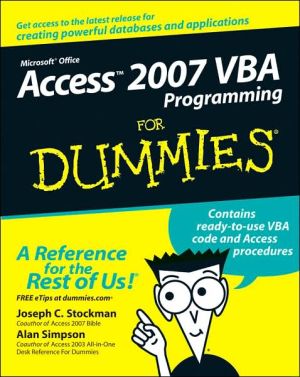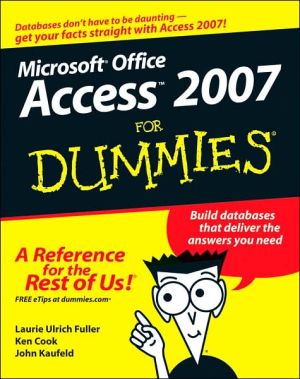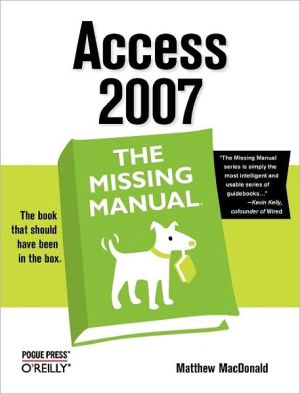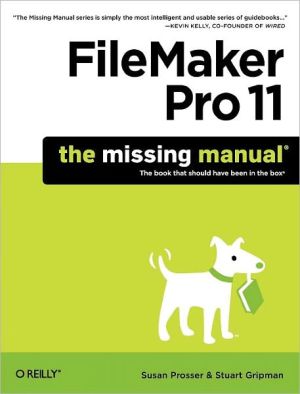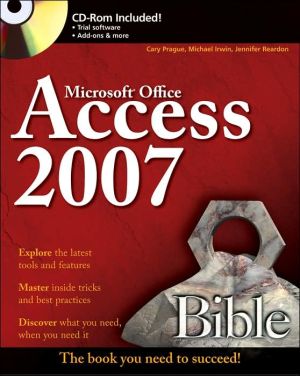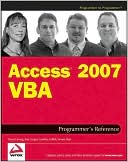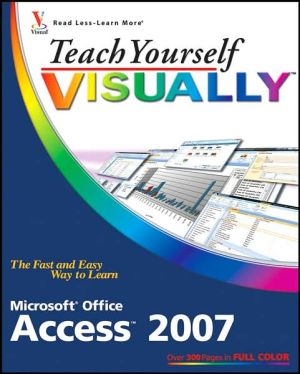Access 2007 VBA Programming For Dummies
If you’ve been using Access for a while, you’re probably aware of its power and potential and itching to take advantage of both. Access 2007 VBA Programming For Dummies takes you beyond forms and reports and shows you how to use VBA to create killer Access databases and applications. This gentle introduction to VBA programming covers everything you need to get started, including:\ \ Basic programming skills and concepts\ Explanations of modules, procedures, objects, and arguments\...
Search in google:
If you’ve been using Access for a while, you’re probably aware of its power and potential and itching to take advantage of both. Access 2007 VBA Programming For Dummies takes you beyond forms and reports and shows you how to use VBA to create killer Access databases and applications. This gentle introduction to VBA programming covers everything you need to get started, including: Basic programming skills and concepts Explanations of modules, procedures, objects, and arguments Access-unique programming activities, including SQL and recordsets How to use the Visual Basic editor Creating dialog boxes, lists, drop-down menus, and functions Integrating with other Office applications Ready-to-use VBA code examples to type in or copy and paste from the Web Completely revised to reflect all changes found in Microsoft Access 2007, Access 2007 VBA Programming For Dummies gives you access to Access like you’ve never had it before.
Introduction 1About This Book 1Conventions Used in This Book 2What You're Not to Read 2Foolish Assumptions 3How This Book Is Organized 3Introducing VBA Programming 3VBA Tools and Techniques 3VBA, Recordsets, and SQL 4Applying VBA in the Real World 4Reaching Out with VBA 4The Part of Tens 4Icons Used in This Book 4Web Site for This Book 5Where to Go from Here 5Introducing VBA Programming 7Where VBA Fits In 9Taking a Look at Access 10Understanding VBA 11Seeing Where VBA Lurks 12Finding standard modules 13Finding class modules 13From VBA to Access 15Finding Out How VBA Works 17Discovering VBA procedures 17Recognizing VBA procedures 18Your VBA Toolkit 21Using the Visual Basic Editor 21Using Project Explorer 23Using the Properties window 24Using the Immediate window 26Using the Code window 27Referring to Objects from VBA 29Setting References to Object Libraries 30Using the Object Browser 30Searching the Object Library 33Jumpstart: Creating a Simple VBA Program 35Creating a Standard Module 35Creating a Procedure 36Understanding Syntax 38Getting keyword help 40Help with arguments 43About named arguments 45Using Existing Code 46Copy and paste code from the Web 46Importing modules 47Modifying existing code 48VBA foots and Techniques 49Understanding Your VBA Building Blocks 51Commenting Your Code 52Understanding VBA Data Types 53Passing Data to Procedures 54Storing data in variables and constants 57Storing data in arrays 58Module-level versus procedure-level 60Naming conventions for variables 61Repeating Chunks of Code with Loops 62Using Do...Loop to create a loop 62Using While...Wend to create a loop 64Using For...Next to create a loop 64Making Decisions in VBA Code 66Using If...End If statements 67Using a Select Case block 68Controlling Access through VBA 71Understanding Object Models 72Distinguishing between objects and collections 72Understanding properties and methods 75Identifying the icons for objects, properties, and methods 77Manipulating Properties and Methods 79Getting the value of a property 79Changing the value of a property 81Using an object's methods 82Seeking help with properties and methods 84Programming Access Forms 87Working with Class Procedures 87Enabling or Disabling Form Controls 90Using VBA to position the cursor 91Choosing an object and event for the code 92Showing and hiding controls 95Making controls read-only 96Responding to Form Events 96Changing the Appearance of Objects 99Changing colors 99Controlling boldface, italics, and such 103Changing special effects 104Using the With...End With statements 104Filling form controls with data 105Opening and Closing Forms 107Closing a form 109Adding a related record to another table 109More DoCmd methods for forms 112VBA, Recordsets, and SQL 115The Scoop on SQL and Recordsets 117What the Heck Is SQL? 117Writing SQL without knowing SQL 120Select queries versus action queries 121Getting SQL into VBA 123Hiding warning messages 124Storing SQL statements in variables 125Creating Tables from VBA 128Creating new tables from existing tables 128Creating a new, empty table from VBA 129Closing and deleting tables through VBA 130Adding Records to a Table 131Appending a single record with SQL 132Query to append one record 133Changing and Deleting Table Records 134Performing an Action Query on One Record 136Working with Select Queries and Recordsets 137Defining a connection 140Defining the recordset and data source 141Filling the recordset with data 142Managing recordsets 143Referring to fields in a recordset 145Closing recordsets and collections 146Putting Recordsets to Work 147Looping through Collections 147Using For Each loops 149Using shorter names for objects 152Tips on Reading and Modifying Code 154Square brackets represent names 154Other ways to refer to objects 155The continuation character 157Skipping Over Used Mailing Labels 159Looking at How SkipLabels Works 162Passing data to SkipLabels 164Declaring variables 165Copying the label report 165Getting a report's recordsource 165Creating the recordset 166Creating LabelsTempTable from MyRecordSet 166Calling a Procedure from an Event 171Applying VBA in the Real World 173Creating Your Own Dialog Boxes 175Displaying and Responding to Messages 176Asking a question 176Designing a message box 177Responding to a MsgBox button click 180Converting Forms to Dialog Boxes 182Storing dialog box settings 183Setting form properties 184Adding controls to the dialog box 187Creating Custom Combo Boxes 189Creating a Spin Box Control 195Detecting a Right-Click 198Customizing Combo Boxes and List Boxes 201Programming Combo and List Boxes 202Listing field names 204Listing text options 207Listing Table/Query field values 212Linking Lists 216Running code when a form opens 218Running code when the user makes a choice 219Linking Lists across Forms 222Updating a combo box or a list box 223Opening a form to enter a new record 225Seeing whether a form is open 226Getting forms in sync 227More Combo Box Tricks 228Using hidden values in combo and list boxes 228Giving users a quick find 232Avoiding retyping common entries 235Creating Your Own Functions 239The Role of Functions in VBA 239Creating Your Own Functions 241Passing data to a function 242Returning a value from a function 243Testing a custom function 244A Proper Case Function 245Looking at how PCase() works 247Using the PCase() function 248A Function to Print Check Amounts 251Using the NumWord function 254Looking at how NumWord() works 256Testing and Debugging Your Code 265Understanding Compilation and Runtime 266Considering Types of Program Errors 268Conquering Compile Errors 269Expected: expression 271Expected: end of statement 272Expected: list separator or ) 272Dealing with Logical Errors 274Checking on variables with Debug.Print 275Slowing down code 279Getting back to normal in the Code window 282Wrestling Runtime Errors 283Responding to a runtime error 283Trapping runtime errors 285Writing your own error handlers 288Reaching Out with VBA 293Using VBA with Multiple Databases 295Client-Server Microsoft Access 296Importing from External Databases 302Linking to External Data through Code 304Avoiding Multiple Tables and Links 305Creating Recordsets from External Tables 308Importing, Exporting, or Linking to Anything 309Using a macro to write the code 309Quick and easy import/export/link 312Integrating with Other Office Applications 315Accessing the Object Library 315Exploring a program's object model 317Meet the Application object 318Connecting to other programs 319Sending E-Mail via Outlook 320Sending Data to Microsoft Word 325Creating the Word template 325Creating the Access form 327Writing the merge code 328Interacting with Microsoft Excel 334Creating the worksheet 335Creating a query and a form 336Writing the Excel code 337Copying a table or query to a worksheet 342Running Excel macros from Access 346The Part of Tens 349Ten Commandments of Writing VBA 351Thou Shalt Not Harbor Strange Beliefs about Microsoft Access 351Thou Shalt Not Use VBA Statements in Vain 351Remember to Keep Holy the VBA Syntax 352Honor Thy Parens and Quotation Marks 353Thou Shalt Not Guess 354Thou Shalt Not Commit Help Adultery 354Thou Shalt Steal Whenever Possible 355Thou Shalt Not Bear False Witness against Thy Object Browser 355Thou Shalt Not Covet Thy Neighbor's Knowledge 356Thou Shalt Not Scream 356Top Ten Nerdy VBA Tricks 357Open a Form from VBA 357See Whether a Form Is Already Open 358Refer to an Open Form 358Move the Cursor to a Control 359Change the Contents of a Control 360Update a List Box or Combo Box 360Show a Custom Message 361Ask the User a Question 362Print a Report 363Get to Know the DoCmd Object 364Index 367
